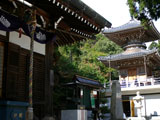
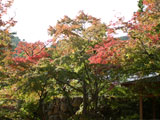
Bantaki Tunnel is found when you travel from Arima Onsen toward the urban area of Nishinomiya via the Nishinomiya-Kita Toll Road (250 yen). Passing through this tunnel, you will see the Jurinji Temple on the right after the third traffic signal. The temple was established in 833 by Kobo-Daishi (Kukai) as part of the Koyasan Shingon Sect and has been adored by local citizens since ancient times as a place for offering prayers to Buddha of Mercy for preventing throat illnesses.
Within these grounds there are several hundreds of trees with leaves that change colors, and many tourists come to see them every autumn. The area features the red-tinted mountain trees of autumn as well as maple, beech, Rhus javanica, and ginkgo trees. Every year "Autumn Leaves Festival" is celebrated and the scenery of autumn leaves within the grounds are lit up from 18:00 to 22:00 starting in mid-November, and the autumn leaves bobbing in the light against the night is spectacular.
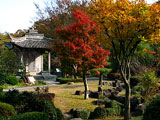
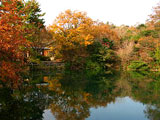
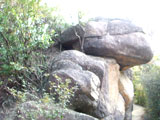
When you precede straight 1km on the prefectural road accessing Jurinji Temple from the Arima Onsen, there is an entrance to the Kitayama Park and Kitayama Botanical Garden (no admittance charge). Within the garden, there is a corner where you can comfortably consult specialists concerning gardening and many kinds of potted plants such as foliage plants that are available for purchase. The Kitayama Mountain Villa, opened to commemorate the 60th anniversary of the incorporation of Nishinomiya City, is opened to the general public and shows Japanese architecture through an elegant Sukiya style building with a splendid Japanese garden containing Kitayama Japanese cedars and trees with leaves that turn a red tint in autumn. Also, "Kitayama Bokkatei Villa" and "Shorantei Villa" recreated in the exact image of a famous place in Shaoxing City, Zhejiang, China, are not to be overlooked. In autumn, the colorful leaves of many tree varieties, including the Quercus serrata which changes colors to orange, can be enjoyed as they paint a lovely palette in the garden surrounded by immense nature.
The Kitayama Park is a vast green area with a general 55,000ću that continues north about 1km of the botanical garden as if encircling the garden. Here, because broadleaf trees grow in a thick forest, hikers can enjoy taking long walks while looking at the red tint of the autumn leaves. Plus, the numerous megaliths seen in the park make the park a spot highly recommended for aficionados of bouldering, a type of rock climbing that does not use rope.
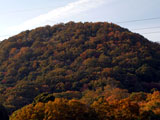
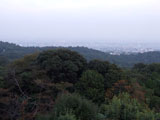
The Mt. Kabuto Forest Park at the foot of Mt. Kabuto was opened in 1970 to commemorate 100 years of the Hyogo Prefecture government. It is a vast park with an area of 770,000ću and a observation platform in this corner looking over Nishinomiya City, making it a popular spot for its beautiful night view. Here people can be content with the beauty of nature in each season with cherry blossoms in spring, azaleas in the beginning of summer, and vivid red-tinted leaves in the autumn. Near the large fountain in the middle of the park are sculptures aligned in a row and made from marble collected from each country of the world that give visitors a chance to be exposed to art while taking a walk through a forest with autumn leaves. Bird watching with binoculars and field athletics are some of the various activities possible in the ideal weather for an outing of autumn, and you will see many families and groups under the beautiful autumn leaves with picnic lunches spread before them.
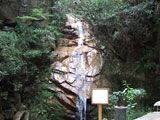
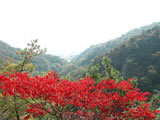
Koza Waterfall is about 10 meters high in a ravine on the west side of Mt. Takao (263m elevation above sea level), a mountain overlooking urban district of Ashiya City. When you go north along the riverbank on the west side of Ashiyagawa River from the Hankyu Ashiyagawa Station, you can see a tributary of the Kozagawa River on the left hand side. If you proceed along this tributary, there is a signpost to the Koza Waterfall. Originally, this was a place where monks in training stood under a waterfall as religious training, but now it is a place famous for autumn leaves and is visited in autumn by a large number of hikers.
When you proceed further to the heart of the mountain, you come to the Ashiya Rock Garden, a place with an exposed white rock surface. A rock cliff of a weathered granite ridge spreads out before you and is a place famous nationwide as a practice area for rock climbing. If you go further north, you will come across Kazefuki-iwa Rocks where you can get a bird's eye view of Osaka Bay spread before you.


Iwagahira Park on the mountainside of Ashiya is about a 4-minute walk from the Hankyu Bus Iwazono-cho bus stop. The park has an area of 6,373m2 and is popular with local residents. It is famous for its cherry blossom trees, but there are also broadleaf trees that can also be enjoyed for their brilliant colors in the autumn. To commemorate the link of sister city with the city of Montebello in California, U.S.A., a garden for enjoying each of the four seasons was established within the park. The garden is named Montebello Rose Garden and features beautiful flowers, beginning with roses and cherry blossoms, blooming at various times of the year. It is particularly beautiful in the beginning of April when the flower petals of from the cherry blossom trees adorn the grounds as a floral carpet.

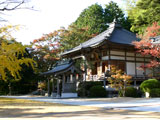
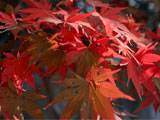
To access Kazan-in Temple, take the bus from the Sanda Station of the JR or Kobe Railway for about 20 minutes and get off at Kazan-in bus stop. Walk about 30 minutes, and you will arrive at Kazan-in Temple. The temple was established in 651 by Hodo-sennin as part of the Shingon Sect and is officially called Tokozan Bodaiji Temple. It is here where abdicated Emperor Kazan spent his life in seclusion from the age of 19 years old and is the reason behind the name Kazan-in Temple. On the premises of the temple within the high-steeped walls surrounding the temple there is mausoleum where worshippers continue to pray. There is also a wooden sculpture of the abdicated Emperor Kazan that is designated as an important cultural item of Sanda City.
Because the Kazan-in Temple is on the mountaintop of the Amida Peak (418m elevation above sea level) soaring over east bank of Senjoji Lake, the observation platform in the garden in front of the temple affords an impressive view spanning the urban district of Sanda City to the Rokko Mountain Range. Surrounding the main hall of the temple are many old trees such as maple and gingko trees, giving the area a beautiful shade of red from the leaves of the old trees changing color in the autumn. Crowds of sightseers come to witness the beauty to see the splendid sight unfold.










